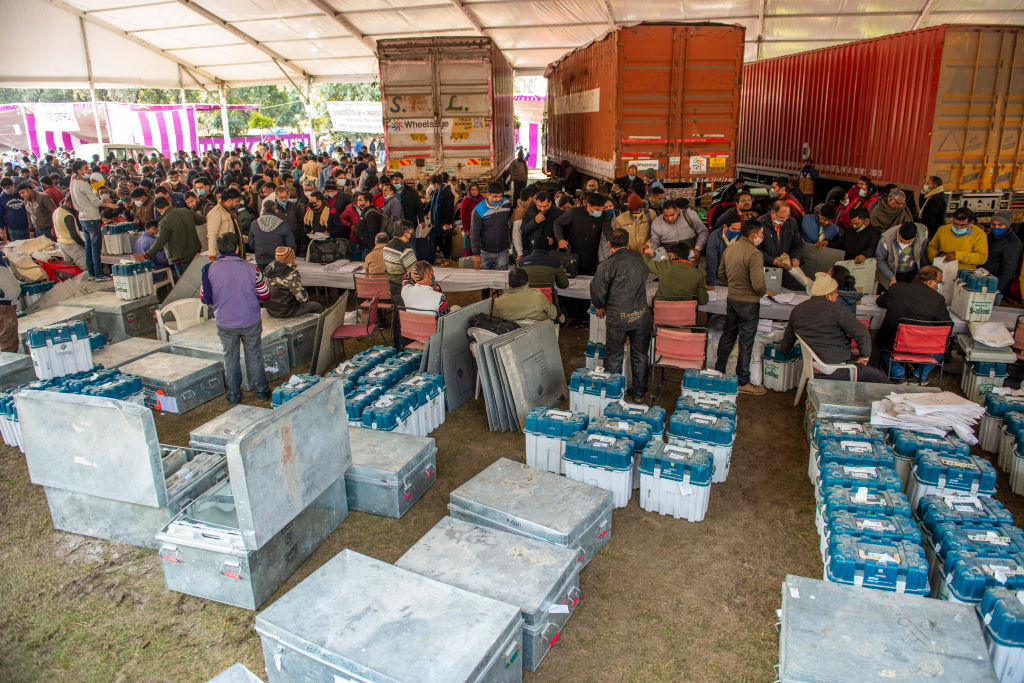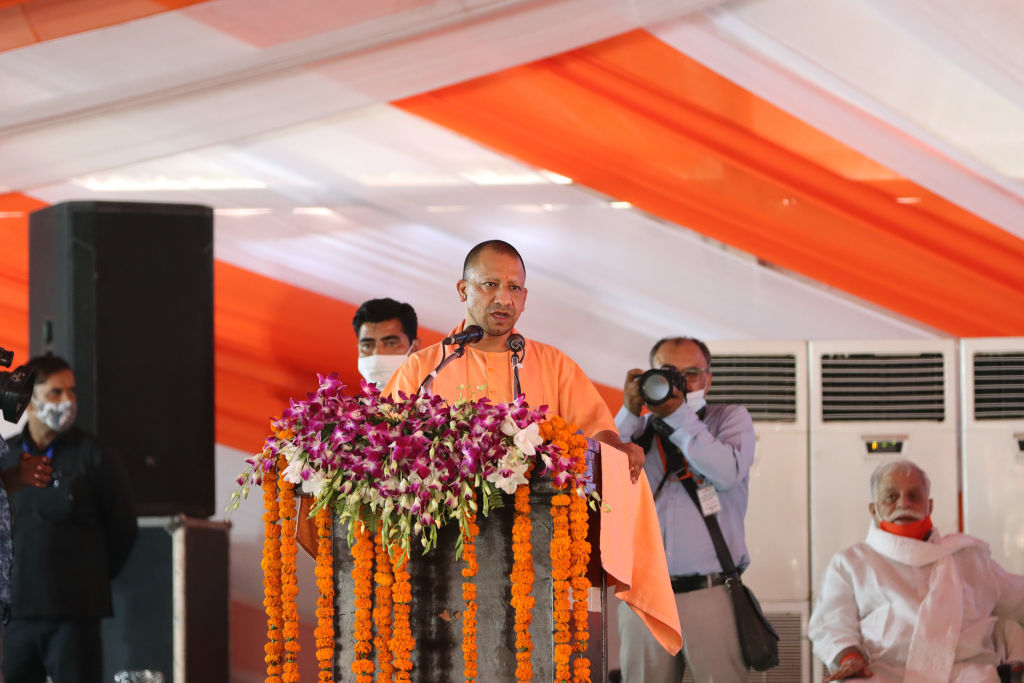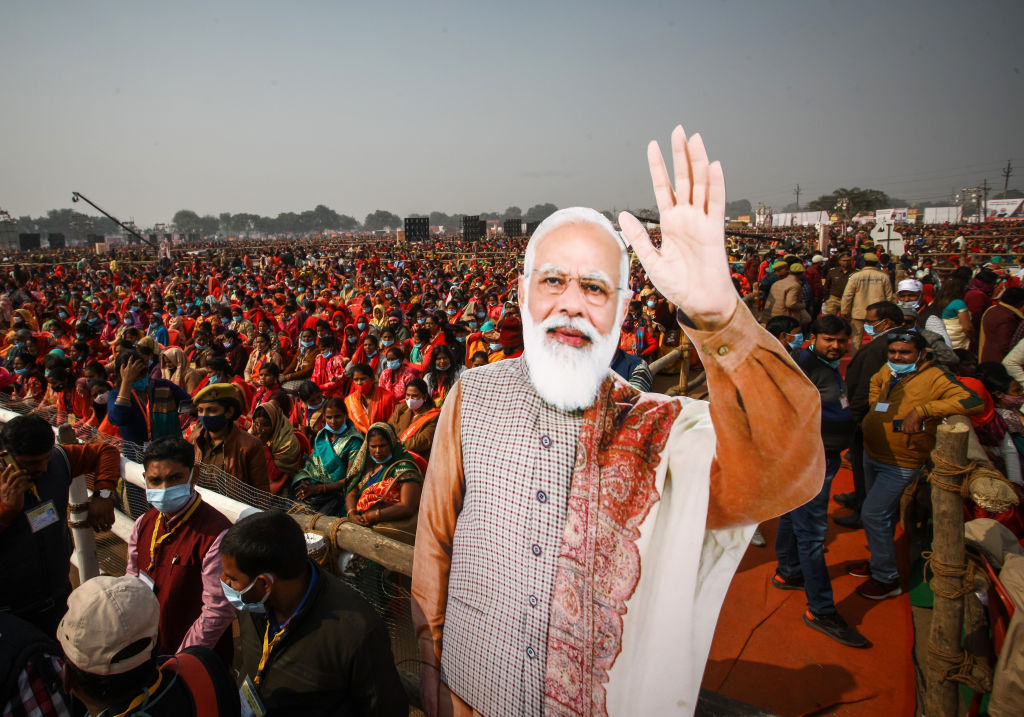
Elections in the Indian state of Uttar Pradesh begin on Thursday, Feb. 10 and the stakes are high. Were Uttar Pradesh a country, its population would make it one of the largest countries in the world. Votes in the state return just over 15% of seats to India’s lower house of parliament.
“Short of a general election in India, it’s the single biggest political prize on offer,” says Milan Vaishnav, director of the South Asia program at the Carnegie Endowment for International Peace.
The bellwether state has long reflected broader sectarian tensions, and the upcoming polls coincide with the midway point of Prime Minister Narendra Modi’s second term in office. Modi has also faced criticism over his administration’s handling of the pandemic, which has so far led to more than 500,000 deaths and health care workers reporting a collapse in the system.
“It’s being viewed by the Indian public as a midterm referendum on his rule,” Vaishnav says—in particular on the Hindu nationalist agenda of Modi’s Bharatiya Janata Party (BJP).
Under the BJP’s watch, disinformation and hate speech toward India’s Muslim minority have soared. Lynchings and attacks on Muslims, who make up 19% of the population in Uttar Pradesh and 14.2% in India as a whole, are commonplace and hardline Hindus have openly called for an anti-Muslim genocide. In December 2019, the Indian parliament passed a discriminatory law that blocks some Muslims from citizenship, and encroached on the historic autonomy of the country’s only Muslim-majority state, Jammu and Kashmir.
Read More:How Long Will Biden Pretend That Modi’s India Is a Democratic Ally?
In Uttar Pradesh, the BJP enacted punitive laws to discourage interfaith marriages, with the state’s chief minister, politician-cleric Yogi Adityanath, promising death for those who “play with the honor” of Hindu women. Headway is also being made on the construction of a temple at the site of a destroyed mosque at Ayodhya, in the eastern part of Uttar Pradesh.
“It’s home to these holy Hindu sites, which in many ways functioned as the nerve center of the BJP’s Hindu politics,” says Dhrubo Jyoti, a New Delhi journalist who reports for The Hindustan Times. “This is the heartland of the Hindutva [Hindu identity] project so if the BJP is unable to retain this state, it’s going to be a symbolic defeat for its agenda, at least temporarily.”
Who’s running and who’s likely to do well?
Political analysts expect that the BJP, currently in control of Uttar Pradesh, will win again with a narrower margin—but given the magnitude of its previous victory, that shouldn’t present problems. Voting will be phased out over a few weeks and ballots will be counted on March 10.
The BJP easily clinched victory in the 2014 and 2019 national elections as well as the last state election in 2017. “The BJP is so far ahead that it can actually stand to lose a significant amount of vote share and still sail through,” says Neelanjan Sircar, a senior fellow at the Delhi-based Centre for Policy Research. Sircar has been spending time in Uttar Pradesh as part of his research on voting trends and says his research so far indicates shifts away from the BJP but that it’s unclear just how competitive the race will end up being.

The BJP’s main opponent in Uttar Pradesh is the socialist Samajwadi Party, led by Akhilesh Yadav. The 48-year-old former chief minister of Uttar Pradesh has emerged as a more effective politician than rivals, according to Vaishnav. “People who really despise the BJP want to look for the group they believe will be able to get the most votes by consolidating the rest of the Hindu vote and bringing together the Muslim vote,” Vaishnav says. He says many believe the Samajwadi Party is the most likely to do that, compared to the centrist and long established Congress Party (INC) and the Bahujan Samaj Party (BSP), which draws support from disadvantaged minorities.
The Samajwadi Party has worked hard to stitch together a number of alliances with smaller parties, which could prove helpful. “In a state where there are so many communities, even a few thousand votes can make the difference,” says Jyoti.
Who is the incumbent minister?
Chief Minister Yogi Adityanath is a monk, Hindu hardliner, and a senior member of the BJP, who campaigned aggressively for the party in the 2017 elections in Uttar Pradesh and was subsequently handpicked for the ministerial position by Modi, despite his lack of experience in government.

“His claim to fame was riling up the Hindu base, demonizing Muslims and overseeing a Hindu vigilante group that often used violence, coercion and threats against the minority community,” Vaishnav explains.
During his tenure, Adityanath has pursued Hindu supremacist policies, replacing names of cities and towns that had a Persian or Islamic origin with Hindu names, revising textbooks to whitewash Mughal history and approving a law banning “Love Jihad”—the supposed practice of converting Hindu women to Islam, through marriage to Muslim men, in a bid to tilt the demographic balance in Islam’s favor. The notion is a Hindu conspiracy theory, with no basis in fact.
Political analysts say that a victory in the state polls will be viewed by the BJP as approval of their heavy-handed tactics. Looking to the future, the ruling party may then see Adityanath’s approach as “the successful prototype for a chief minister,” Sircar says.
A BJP win would also help cement Adityanath’s personal political future. “If the BJP wins Uttar Pradesh—and especially if it retains a decisive majority—Yogi Adityanath will become one of the tallest leaders of the BJP,” Jyoti says, second only to Prime Minister Narendra Modi and Home Minister Amit Shah.
Many have speculated that Yogi Adityanath will become the next leader not just of Uttar Pradesh but of India itself.
Read More:Why India’s Most Populous State Just Passed a Law Inspired by an Anti-Muslim Conspiracy Theory
What are the biggest issues?
Sectarian issues will likely be the most important issue on voters’ minds. “Uttar Pradesh has become ground zero for a certain type of Hindu-Muslim polarization and its effect on national politics,” Sircar says. “The big question will be the extent to which Muslim polarization is going to work as an electoral strategy.”
Almost two-thirds of Hindus say it is very important to be Hindu to be truly Indian, according to a Pew survey of almost 30,000 Indian adults between late 2019 and early 2020. Unsurprisingly, such voters form Modi’s power base, with “60% of Hindu voters who think it is very important to be Hindu and to speak Hindi to be truly Indian” casting their vote for the BJP, “compared with 33% among Hindu voters who feel less strongly about both these aspects of national identity.”
Much BJP rhetoric focuses on the idea that Hindus are made to feel like a minority in their own country. “There are all these dog whistles built around this idea of Hindu victimhood in a place where the legacy of partition still looms large,” says Vaishnav. He explains that given the “history of religious violence and riots, these slogans and campaign pitches do have resonance.”
Read More: Is India Headed for an Anti-Muslim Genocide?
Criticism of the BJP’s handling of the economy is also emerging as a hot-button issue.
Economists say that the rising cost of living in addition to increasing unemployment and inflation has led to a crisis. The country’s unemployment rate increased to almost 8% in December from closer to 7% in November and below 5% in 2017, according to Al Jazeera English. India’s youth, in particular, have been hard hit; the Centre for Monitoring Indian Economy reported that nearly 30 million Indians aged 20 to 29 accounted for the vast majority of those who are unemployed, Al Jazeera English stated. “Many of the youth who we associate with supporting the BJP and Modi are not as excited about the BJP because of unemployment and the jobs crisis,” Sircar says. He notes that elections in Uttar Pradesh have “not been fought on economic grounds for a very long time” so it would be a big shift if discontent around the economy would disrupt voting patterns tied to Hindu Muslim polarization.
Widespread opposition to agricultural reforms that protesters said would favor big agribusiness at the expense of smaller farmers have also been a big concern for the ruling party. While many of the protests occurred in Punjab and Delhi, farmers in the Western parts of Uttar Pradesh also mobilized against the laws. Modi repealed the measures in November after a year of bitter protest, but it is unclear whether this will be enough to restore goodwill among these farmers, many of whom are still calling for the expansion of a government scheme to buy produce at minimum support prices.
This is also the first election after a devastating second wave of COVID-19 last spring. In Uttar Pradesh, there were bodies floating down the Ganges, mass graves, and shortages of oxygen and hospital beds. However, analysts say much of the discontent may be targeted towards district-level officials instead of state and national ones.
In terms of direct political impact, the effects of the farmers’ protest and pandemic may be limited, according to Sircar. “Nobody says I will vote for this party or that party because of the farmers protests or because of the pandemic despite all the horrible things that have happened,” he says.

What could the results mean for Modi?
The BJP’s goal will be to use a victory in Uttar Pradesh to “create an aura of inevitability about the 2024 [national] election,” Vaishnav says, as well as to spark tumult among opposition parties, who may look to shuffle their leaders. The Uttar Pradesh election will in particular be a test of Akhilesh Yadav’s popularity.
Jyoti cautions that even if the opposition fares well in Uttar Pradesh, it’s no guarantee that Modi’s personal appeal will be significantly affected in 2024. Even when the BJP does poorly in Indian state polls, it often performs well in those same areas when it comes to a national vote.
Defeat for the BJP, though unlikely, could prompt the party to reevaluate its strategy and whether Yogi Adityanath is the right choice for chief minister. “If Uttar Pradesh falls, there will be a genuine questions about whether the BJP can turn it around given that it’s been such a laboratory for Hindu Muslim polarization,” Sircar says.
But whatever happens, Modi’s own position will likely be safe.
As Vaishnav puts it, “there is nobody who can go head to head with Modi at the national level.”
— Additional reporting by Eloise Barry/London
More Must-Reads from TIME
- Cybersecurity Experts Are Sounding the Alarm on DOGE
- Meet the 2025 Women of the Year
- The Harsh Truth About Disability Inclusion
- Why Do More Young Adults Have Cancer?
- Colman Domingo Leads With Radical Love
- How to Get Better at Doing Things Alone
- Michelle Zauner Stares Down the Darkness
Write to Sanya Mansoor at sanya.mansoor@time.com